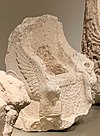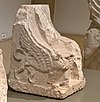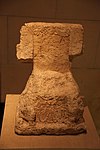Thrones_of_Astarte
Thrones of Astarte
Phoenician votive thrones
The Thrones of Astarte are approximately a dozen ex-voto "cherubim" thrones found in ancient Phoenician temples in Lebanon, in particular in areas around Sidon, Tyre and Umm al-Amad.[1] Many of the thrones are similarly styled, flanked by cherubim-headed winged lions on either side.[2] Images of the thrones are found in Phoenician sites around the Mediterranean, including an ivory plaque from Tel Megiddo (Israel), a relief from Hadrumetum (Tunisia) and a scarab from Tharros (Italy).[2]
Places associated with the Thrones of Astarte
More information Image, Period ...
| Image | Period | Location found | Current location | Inscription | Description | First published |
|---|---|---|---|---|---|---|
 | Hellenistic | Byblos | National Museum of Beirut | none | On the front, two figures pouring a libation into a flower. On the seat, rectangular anathyrosis for placing an object.[3] | Dunand[4] |
 | Hellenistic | Sidon | National Museum of Beirut | none | On the front, a Phoenician palmette. On the seat, a large rectangular mortise used to fix an object. Backrest without decoration.[3] | 1941 Dunand[5] |
 | Roman | Sidon | National Museum of Beirut | Greek inscription | Seat very tilted, unable to hold an object. The back shows a globe inside a crescent.[3] | 1924[6] |
 | Sidon | Louvre | none | Naiskos in which is a throne with two sphinxes. Above the seat, U-shaped cavity, intended to receive an object rounded at the bottom: perhaps a round baetylus and its crowns. On the side faces, officiating priests.[3] | 1933[7] | |
 | Sidon | Istanbul Archaeology Museums | none | Naiskos analogous to the previous one. At the back is a small cavity, intended to hold an object. On the sides, winged goddesses of Egyptian style.[3] | [8] | |
 | 2nd century BCE | Khirbet et-Tayibeh, near Ras al-Ain near Tyre | Louvre | Phoenician dedication to Astarte, known as KAI 17 | On the throne, two stelae with reliefs, depicting two standing officiants.[3] | 1907 Ronzevalle[9][10][11] |
 | Hellenistic | Ain Baal near Tyre | National Museum of Beirut | none | Seat contains a stele or baetylus[3] | |
 | Hellenistic | Region of Tyre | National Museum of Beirut | none | Seat contains a stele or baetylus[3] | |
 | 4th century BCE | Umm al-Amad | Louvre | none | On the front, a Phoenician palmette[3] | 1860, Renan[12] |
 | Umm al-Amad | National Museum of Beirut | none | The front is broken. Horizontal seat, rounded front. Backrest without decoration. Large throne which could fit a person.[3] | Dunand | |
 | Temple of Eshmun | Temple of Eshmun | none | Dunand | ||
 | Temple of Eshmun | National Museum of Beirut | none | Dunand | ||
 | Hellenistic | Unknown | National Museum of Beirut | none |
Close
- A similar throne depicted on the Ahiram sarcophagus[13]
- KAI 17 (photo)
- KAI 17 (copy)
- Ivory plaque with Throne of Astarte
- Punic statue from Tunisia (Sanctuaire de Thinissut)
- Scarab with Throne of Astarte
- Milik, 1967
- Davila and Zuckerman (1993), p.77: "Compare the votive throne discovered at Umm el-'Amed (Dunand and Duru 1962: 168 pl. 67). The lower part of the throne is badly damaged, but the heads are preserved. The heads are human, and each bears a head-dress or coiffure that reaches down to the shoulders. They also have stylized beards. On our throne, what remains of the headdresses/coiffures and beards of the cherubs stylistically parallels those of the Umm el-'Amed cherubs. In fact, it seems quite probable that they stem from the same artistic and iconographic milieu. We may further note the cherub thrones depicted on a Late Bronze/ Iron I ivory from Megiddo, the sarcophagus of Ahiram (cf. Pritchard 1969: figs. 332, 456-59, respectively), a relief from Hadrumetum/Sousse (Cintas 1947: pls. 48-49), and a scarab from Sardinia (Bisi 1967: fig. 57). In each of those exemplars the cherubs have a feline body with wings, a tail, and styled hair, but no beard."
- Henri Seyrig's original list of 10 known thrones in 1959: Seyrig, 1959, page 51-52
- M. Dunand, Excavations of Byblos, II, p. 79, no.7225, p. 152
- Dunand, Bulletin du Musée de Beyrouth, V, 1941, p. 93, where the origin is given as unknown.
- Ch. Virolleaud, Syria, V, 1924, p. 119, pi. 32, where the origin is given as unknown. The throne had been received in Sidon by L. Brossé: cf. Noel Aimé-Giron, Bulletin de l'Institut Français d'Archéologie Orientale, XXV, 1925, p. 206
- Noel Aimé-Giron, Bulletin de l'Institut Français d'Archéologie Orientale, XXXIV, 1933, pp. 31-; R. Dussaud, Syria, XIV, 1933, pp. 335-
- G. Mendel, Catal. of sculpt. (Museums imper. Ottom.), I, n ° 92 (attribution in the 5th century); Noel Aimé-Giron, Bulletin de l'Institut Français d'Archéologie Orientale, XXV, 1924, pp. 191-; cf. R. Dussaud, Syria, VI, 1925, pp. 95-
- Sébastien Ronzevalle, Note sur un monument phénicien de la région de Tyr; In: Comptes rendus des séances de l'Académie des Inscriptions et Belles-Lettres, 51ᵉ année, N. 10, 1907. pp. 589-598; DOI : https://doi.org/10.3406/crai.1907.71970
- Clermont-Ganneau, in Repert. epigr. sémit., n ° 800.
- E. Renan, Mission de Phénicie (1865–1874), p.707 and plate LIII: "Le petit fauteuil représenté planche LIII est une restitution en partie hypothétique de l’ensemble formé par deux fragments que nous avons rapportés (au Louvre, Catal. n° 75 et 76). Le globe ailé, les bras en forme d’aile, les sculptures fines, quoique très-frustes, du devant sont certains. Les figures des angles sont très-difficiles à agencer." [translated: "The small armchair shown on Plate LIII is a partly hypothetical restitution of the whole formed by two fragments that we have brought back (to the Louvre, Catal. N ° 75 and 76). The winged globe, the wing-shaped arms, the fine, though very rough, carvings on the front are certain. The angle figures are very difficult to arrange."
- Noël Aimé-Giron, Un ex-voto à Astarté, BIFAO 25 (1925), p. 191-211
- Sébastien Ronzevalle, Le "Trône d’Astarté", Mélanges de la Faculté Orientale (Beirut) 3 (1909), 755–83, pls 9–10;
- Sébastien Ronzevalle, ‘Note sur un monument phénicien de la région de Tyr’, CRAI (1907), 589–98
- James R. Davila and Bruce Zuckerman (1993). The Throne of ʿAshtart Inscription. Bulletin of the American Schools of Oriental Research, (289), 67–80. doi:10.2307/1357365
- Józef Milik (1967). Les papyrus araméens d'Hermoupolis et les cultes syro-phéniciens en Égypte perse. Biblica, 48(4), 546–622. Retrieved July 28, 2020, from www.jstor.org/stable/42618436
- Henri Seyrig. Antiquités syriennes. In: Syria. Tome 36 fascicule 1–2, 1959. pp. 38–89; doi : https://doi.org/10.3406/syria.1959.5447 https://www.persee.fr/doc/syria_0039-7946_1959_num_36_1_5447
- Edward Lipiński, Rereading the Inscriptions of the ‘Throne of Astarte’ and the Sidonian Obelisk, Journal of Semitic Studies, Volume 61, Issue 2, Autumn 2016, Pages 319–325, https://doi.org/10.1093/jss/fgw011
 Media related to Thrones of Astarte at Wikimedia Commons
Media related to Thrones of Astarte at Wikimedia Commons- Lion-Throned Goddesses of West Asia
- Classical Art Research Center: 20. Seated goddess Archived 2020-02-11 at the Wayback Machine